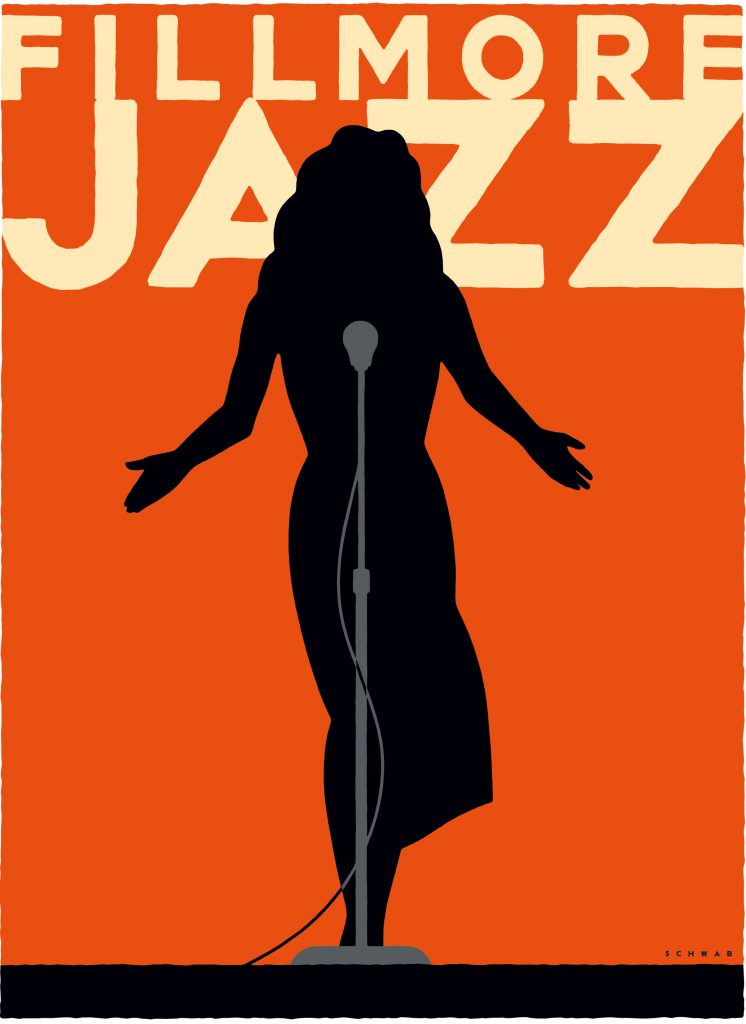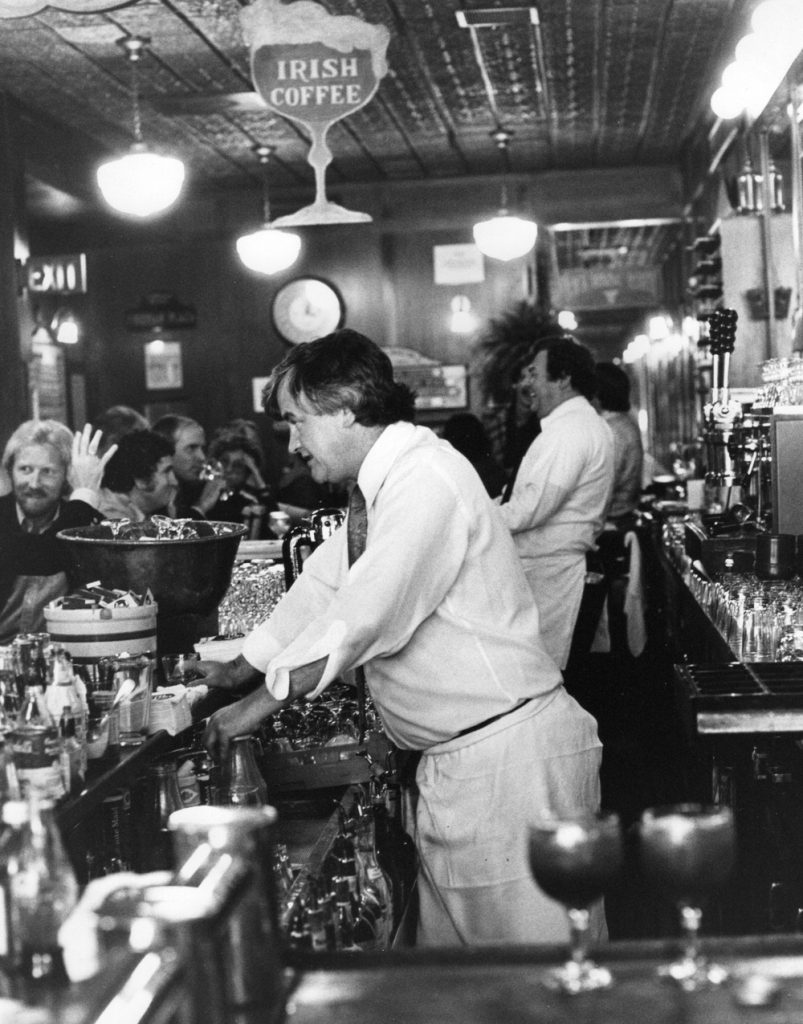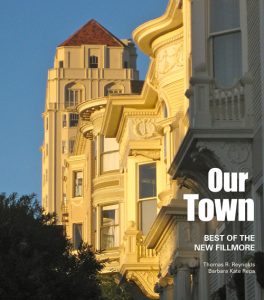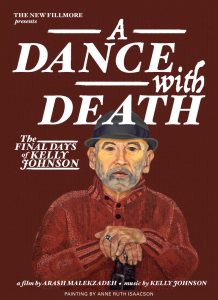By Chris Barnett
DID YOU HEAR the one about the architect in a cab on Union Street who realized he was short of money? “Pull over at Perry’s; they’ll cash a check,” he told the cabbie. “Wait here,” he said to his date. “I’ll be right out.”
As he walked in, barkeep Michael McCourt yelled “Hey Russ, the usual?” and poured him a stiff one. Another regular came over. “Hey Russ, good to see you. Let me buy you a drink.” Another pal waved from down the bar. “Next one’s on me.”
Ten years later, the architect, Russell Gifford, was perched on his favorite stool at Perry’s and his date from that night walked in the door. He saw her in the backbar mirror, turned around and cracked: “I thought I told you to wait in the cab.”
The top bartenders in town — who worked at Perry’s at some point in their careers — are still telling that one. Yet this month on the 45th anniversary of the Union Street thirst parlor and restaurant bearing his name, you would never hear that tale told by the proprietor, Perry Butler. He’s too much of a gentleman.
In a city where barrooms have morphed from brawling whiskey and beer joints in canvas tents to temples staffed by high priests of the shot glass who dub themselves cocktailians and mixologists, Perry’s on Union stands alone as San Francisco’s last great saloon.
At 45 years old, Perry’s is far from the oldest bar in town. As seasoned San Francisco elbowbenders know, The Saloon in North Beach, best known these days for blues music, and Elixir at 3200 16th Street in the Mission, noted for creative cocktailing, are forever battling for that distinction.
And Perry’s is not the hippest, hottest, happeningest bar in San Francisco where young and beautiful power drinkers pile in with pals to hang out and catch up, or slide in solo on the prowl and mostly on the make. That was once Perry’s rep, in the ’70s and early ’80s, when it was the city’s reigning pick-up bar.
Today, what makes Perry’s on Union worthy of grand note is that it hasn’t changed in four and a half decades, philosophically or physically. It opened with friendly, wise-cracking, well-seasoned bartenders who had the wit and brains to banter with customers and keep them coming back. And it still has a warm, woodsy late ’60s decor festooned with photographs, paintings, posters and framed front pages that cover virtually every inch of every wall space.
It’s no surprise the owner is no fan of change for the sake of change; in fact, he’s changed very little himself. Sure, Perry Butler’s hair is a little grayer and a little shorter at 71. He’s no longer wearing those plaid, wide-lapel sportcoats he favored in the 1970s. But he still has the look of the boyish Dartmouth preppie he was in his 20s when he decided to bail out of the ad agency business and, along with his former wife, Katherine, open a bar and restaurant that mirrored Martel’s, their favorite spot on the Upper East Side of Manhattan.
“We lived in the Marina and a real estate guy showed us this rundown building that was a contractor’s office and we said, ‘OK, we’ll take it,’ ” Butler recalls. “There was no scientific study, no business plan on why we should be on Union Street, which was a pretty sleepy neighborhood back then. It was all seat-of-the-pants.”
Even though Butler’s name was on the door, he says he never wanted to be the “out front guy.” His bartenders were his headliners — and he booked the best.
Mike Fogarty, one of the many Irish Michaels who have tended bar at Perry’s over the years, now the day bartender at Balboa Cafe, recalls the early line-up: “First thing, he hired Michael McCourt and brought him up from Los Angeles. He hired Seamus Coyle. He hired Mike English, the best bartender I’ve ever seen in my life. English could pour drinks, have three dice games going and tell you what the stock market was doing that very minute,” he says.
“You can put a white shirt on a gorilla and he can make a cocktail. But Perry knew the importance of hiring real bartenders,” Fogarty adds. “I’m a bartender. If someone calls me a mixologist, I’ll piss on their shoes. Perry knew it was all about attracting regulars. Same guys. Same seats. Same drinks. Every day. That’s when you know you’ve got a real saloon.”
Irish-born Mike English, who hung up his apron a few years ago, says Butler’s band of merry men and women who worked the bar and the floor were masters at cultivating regulars. “I’d work the end of the bar nearest to the front door,” he remembers, “and I’d make little bets with myself. If someone walked in and I wanted him as a regular, I’d introduce him to other regulars, make him feel at home.”
English signed on at Perry’s in the mid-’70s when the place was really rocking and rolling. “It was bedlam day and night. Famous people from all over the United States — politicians, TV and movie people, admen, newspeople, sports stars — all of them flocked to Perry’s along with local regulars because it was the first New York style bar in San Francisco,” says English. “I did so much drinking I can’t remember it all, and that’s why I haven’t had a drink in 34 years. Perry? He was not a drinker. He’s a straight arrow. In all the years I’ve known him I’ve never seen him have more than one alcoholic drink. You can tell he’s not Irish.”
But then as now, Perry’s on Union is not the place to go to be dazzled by exotic creations. “From the beginning and ever since, we’ve done no fancy cocktails. We don’t do Brandy Alexanders or drinks with umbrellas,” says Butler. “Tons of Bloodies, tons of Ramos Fizzes, which died out because of the egg thing. They say the classics are back, but we never stopped doing the classics.”
McCourt, who today pulls some day shifts during the week at Original Joe’s on Washington Square along with Mike Frazier, another Perry’s alum, was more than the leadoff bartender of Butler’s all-star team. He was the owner’s alter ego, worldly enough to toss it back and forth on any subject with the saloon’s well-traveled customers, friendly enough to keep them coming back for more, yet tough enough to puncture the balloons of pompous blowhards. With Butler’s encouragement and blessing, McCourt created a cocktail culture of camaraderie and good cheer at Perry’s that’s been preserved by the barmen and barwomen who have followed in his footsteps.
“Michael has never suffered fools,” says Seamus Coyle, a San Francisco bartending legend who worked the plank at Perry’s in those early days. “I remember one day when Michael was working a large drink order on a busy night and this guy, annoyed he wasn’t being immediately served, roared: ‘Do you know who I am?’ Michael looked him in the eye and shot back, ‘No, I don’t know who you are. I’ll bet you don’t know who you are. And if you don’t know who you are, why the hell would I know who you are?’ ”
Perry’s opened, pouring 75-cent to 85-cent cocktails alongside eight-ounce glasses of the best jug wine available and priced at 50 cents — and a parade of celebrities flooded through. “It was incredible,” McCourt recalls. “One of the first people through the door was Bob Mathias, the Olympic decathlon gold medalist. There was Charlton Heston, Jason Robards, Joe Montana. O.J. came in every Saturday for brunch and couldn’t have been nicer.”
The notoriety had a drawback. “We were fighting to be a good restaurant — which we were at the time — when Herb Caen wrote an item that we were a singles bar, a body exchange. And overnight, that’s what we became all throughout the ’70s,” says Butler. “It always bothered me. Took us to the lowest common denominator. But we survived it.”
Coyle, who was recruited by McCourt, and who’d joined Perry’s six months after it opened as a maitre d’ to fill the tables in the backroom but quickly moved behind the bar, says Butler has an instinctual gift for running a great joint. “He hired young and old pros, people with personality — and then he’d let the staff alone,” Coyle says. “He would come up with an idea, but he wouldn’t force it on you.” Butler’s resistance to change paid huge dividends. “You want a bar and a restaurant to be predictable, comfortable. You go to a bar to see new and old friends,” says Coyle.
But 45 years don’t go by without some changes. Perry’s barkeeps today are still pouring lots of vodka and gin martinis, Scotch, bourbon, wine, beer and the classic cocktails, including the born-again favorite from the ’50s, the Moscow Mule. Drink prices have crept up, but not that much — from 85 cents on opening day to an average of $7 to $10.
Perry’s circa 2014 may look and feel the same, and many of the same customers from yesteryears are on the same barstools, but the place is a lot mellower. “What’s changed are the drinking habits of the clientele,” says Katharine Wals, a Perry’s regular who favors an Early Times Manhattan straight up. “The drinks are still as generous, but you drink fewer of them — like one, or maybe two.”
Bob Johnson, sitting next to Wals at the bar, agrees. “I’m still drinking Scotch, rocks, twist in a wine glass but no longer am I having seven or eight in one night,” he says. “That’s when the Waldo Grade became the Ho Chi Minh Trail.”
The regulars who are addicted to the staples on the menu — how-you-want-it burger, calamari and Cobb salad — are still meeting their friends at Perry’s, but often bringing their kids.
Kai Vance, who’s been a regular at Perry’s for 23 years for dinner and a beer, had a sidekick with him on a recent Friday night: his son Kyle. “I knew I could come here tonight with my son and I’d run into my buddies,” says Vance. Kyle, too, made a friend in barkeep Carolyn Cherry, who hugs and carries him as she freepours a Gordon’s Gin and tonic. Perry Butler, who has five children, has always run a kid-friendly place.
The bar at Perry’s still is a relaxing meet-and-greet venue. It’s been ingrained in the DNA of the place since the original bartenders started cultivating regulars. Dave Dempsey, recently winding down at Perry’s after a long, stressful shift at work, says: “I was married 38 years and lost my wife, but I met my new girlfriend here seven years ago and we’ve been together ever since, thank God. I love this place: the games on TV, the long bar, the neighborhood feeling and the mature crowd. I feel safe here. Seems like you can always find a seat at the bar.”
PERRY’S ON FILLMORE? IT ALMOST HAPPENED
Perry Butler, whose storied San Francisco bar and restaurant put Union Street on the map as the cradle of civilized imbibing in the company of regulars, almost had a Fillmore Street address. In 2004 he had a chance to buy The Elite Cafe, but his financial advisor talked him out of it. He’s still kicking himself.
“Sam Duvall created the Elite, sold it to Tom Clendening, who wanted to sell it, but it was way overpriced,” says Butler. “We wouldn’t have changed anything — just polished it up. But my financial guy shot it down. Peter Snyderman — a good guy — bought it when we bowed out and he’s made some very good changes. One of my regrets is that I didn’t do that deal.”
He missed out on the Elite, but Butler went on to hang out his familiar shingle on the Embarcadero, in the Design Center and in Terminal 1 at SFO. Along the way several other ventures flopped, including a painful foray into Mill Valley. But ever the optimist, Butler remains in an expansive mood and is “looking for one more great location,” he says. “I would love to go back to Marin.”
Research assistance by Veronika Torgashova
Filed under: Food, Drink & Lodging








